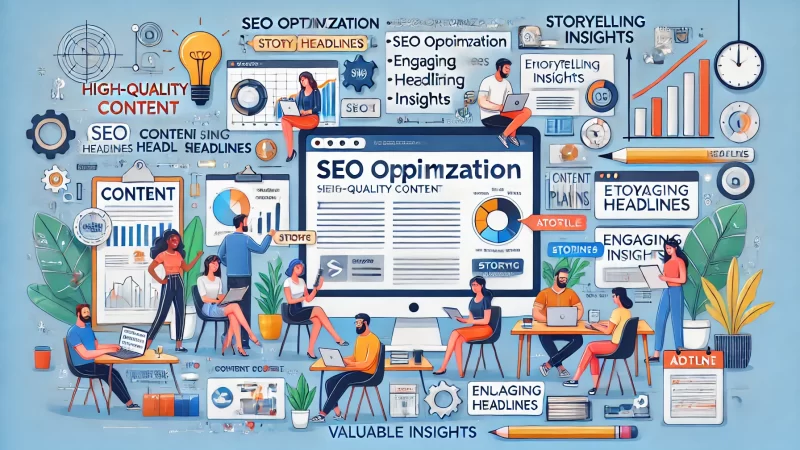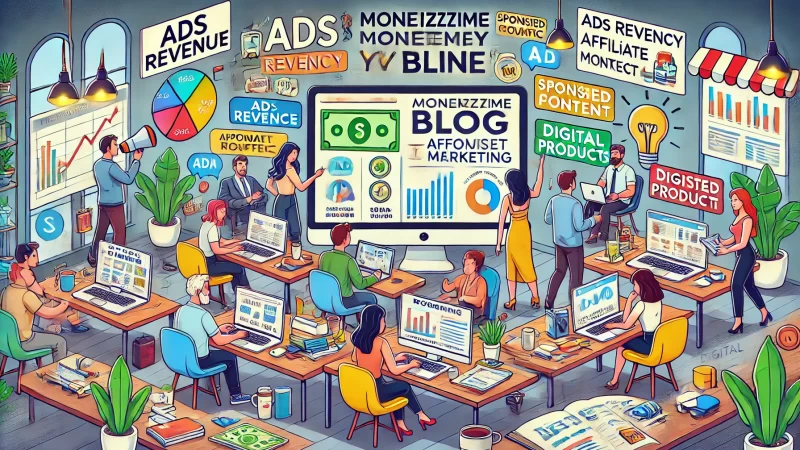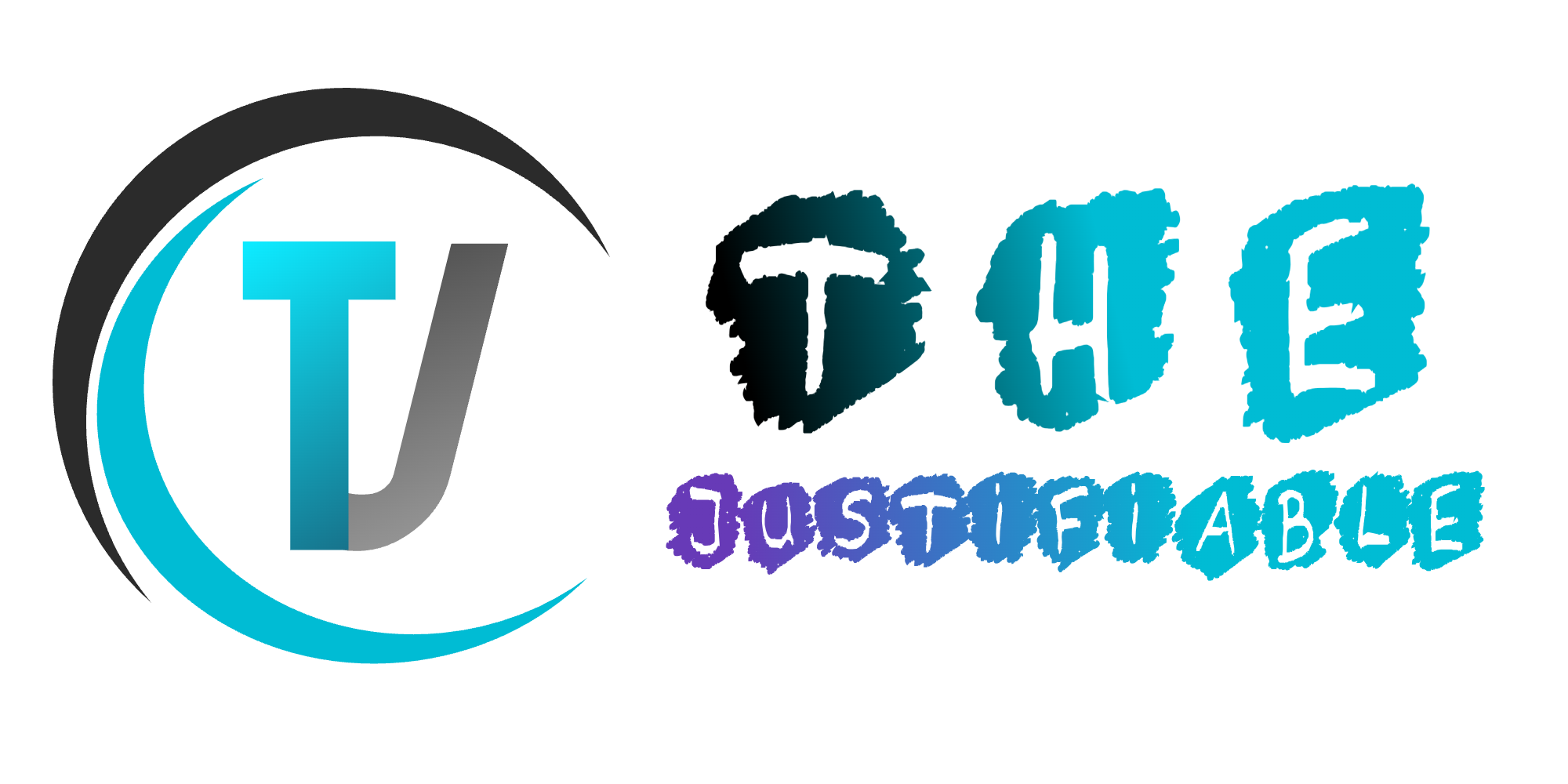Table of Contents
Have you ever wondered how to start blogging to earn money online but felt overwhelmed by where to begin? Is it still possible to make a profitable blog in 2025, or is the market too saturated? What are the best ways to turn a blog into a steady income source?
The good news is that blogging is still one of the most effective ways to make money online—but only if you do it the right way. Choosing a profitable niche, setting up your blog correctly, and using the right monetization strategies can help you build a successful online business.
In this guide, I’ll walk you through everything you need to know to launch a blog, grow an audience, and turn your content into a reliable income stream. Whether you’re a complete beginner or looking to scale an existing blog, you’ll find actionable steps to help you succeed.
Let’s get started!
Beginner’s Guide to Start Blogging and Make Money
Starting a blog to earn money online can be an exciting yet overwhelming journey. Many people dive in without fully understanding how blogs generate income, what skills they need, or the misconceptions that can hold them back. This section will break down the essentials, giving you a clear roadmap to success.
Understanding How Blogging Generates Income
Blogging can be a profitable venture, but it’s not as simple as writing a few posts and waiting for money to roll in. A successful blog monetizes its audience in multiple ways, turning traffic into a reliable income stream.
One of the most common income sources is advertising, where bloggers get paid for displaying ads on their site. This can be done through networks like Monetag or premium ad platforms that offer better rates. However, ads alone won’t make a blog profitable unless there is substantial traffic.
Another powerful income method is affiliate marketing, where bloggers recommend products or services and earn a commission for every sale made through their referral links. This approach works best when promoting products relevant to the blog’s niche, making the recommendations more authentic and trustworthy.
Selling digital products, such as e-books, online courses, or templates, is another effective strategy. Many successful bloggers create their own products to provide value to their audience while maintaining full control over pricing and profits.
Other monetization methods include sponsored content, where brands pay bloggers to promote their products, and membership sites, where exclusive content is offered to subscribers for a fee. By combining different income streams, bloggers can build a sustainable business that isn’t reliant on a single revenue source.
Essential Skills Needed to Succeed as a Blogger
While blogging doesn’t require a degree, certain skills can make a huge difference in how quickly you succeed. The most important one is writing ability—not just grammar and spelling, but also engaging storytelling and clarity. Readers should find your content valuable, easy to understand, and enjoyable to read.
SEO (Search Engine Optimization) is another crucial skill. Learning how to optimize blog posts for search engines helps attract organic traffic, which is often the most sustainable way to grow a blog. Understanding keyword research, on-page SEO, and backlink building can significantly improve visibility.
Marketing and promotion skills are also essential. Writing great content isn’t enough if no one reads it. Knowing how to use social media, email marketing, and content distribution strategies can bring in readers and keep them engaged.
Time management is key for bloggers juggling content creation, marketing, and monetization efforts. Setting a content schedule and staying consistent with publishing new posts helps build trust with an audience.
Lastly, adaptability is vital. Blogging trends and digital marketing strategies change over time, so successful bloggers continuously learn and adapt to stay ahead of the competition.
Common Myths About Blogging for Money
Many people hesitate to start blogging because of misconceptions that make it seem harder or less profitable than it actually is. Let’s clear up some of the most common myths.
One of the biggest myths is that blogging is too saturated to be profitable. While it’s true that competition exists, there are always opportunities for fresh voices and unique perspectives. The key is finding a niche that aligns with both your passion and market demand.
Another common myth is that bloggers make money overnight. While some people achieve quick success, most bloggers take months or even years to build a profitable site. Consistency, high-quality content, and smart monetization strategies are necessary for long-term success.
Some believe that only experts can start a blog, but in reality, many successful bloggers start with little knowledge. What matters most is a willingness to learn and share valuable insights. Readers often appreciate authenticity over perfection.
Lastly, there’s a misconception that you need thousands of daily visitors to make money. While high traffic helps, even a small but engaged audience can be highly profitable through targeted monetization, such as premium content, consulting, or affiliate marketing.
Key Takeaway
Starting a blog to earn money online is possible, but it requires a clear strategy and the right mindset. Understanding how income is generated, developing essential skills, and avoiding common misconceptions can put you on the right path to success. The next step? Finding the perfect niche that aligns with both your interests and profitability potential.
Choosing a Profitable Blog Niche in 2025

Finding the right niche is the foundation of a successful blog. Without a clear focus, it’s easy to get lost in an oversaturated market or struggle to attract an audience. A profitable niche balances your passion, audience demand, and monetization potential. Let’s explore how to identify a niche that sets you up for success.
Factors to Consider When Selecting a Niche
Choosing a blog niche isn’t just about writing what you love—it’s about finding a topic that people actively search for and are willing to spend money on. The first factor to consider is your personal interest and expertise. Blogging requires consistency, so selecting a niche you enjoy will make it easier to stay motivated over time.
Another crucial element is audience demand. A niche must have a sizable audience actively looking for content and solutions. Keyword research tools like Google Keyword Planner or Smrush can help identify search volume trends and confirm whether people are interested in your topic.
Monetization potential is just as important. Some niches attract high-paying advertisers and brands looking for sponsorships, while others work well with affiliate marketing or digital product sales. Researching how competitors monetize their blogs can provide insight into potential revenue streams.
Competition level is another key factor. While high competition isn’t necessarily bad, it’s important to find an angle that makes your blog unique. Identifying gaps in existing content or targeting a specific audience segment can give you a competitive advantage.
Lastly, consider long-term sustainability. Some niches are seasonal or trend-driven, while others remain profitable for years. Choosing a niche with evergreen potential ensures long-term growth and financial stability.
Most Profitable Blogging Niches This Year
Certain niches consistently generate high earnings because they align with strong consumer demand and spending habits. One of the top-performing areas is finance and investing, where readers look for advice on saving money, investing, and managing debt. Finance blogs monetize well through ads, sponsored content, and financial product affiliates.
Health and wellness continues to be a lucrative space, with sub-niches like mental health, fitness, and holistic living attracting dedicated audiences. Bloggers in this space can earn through coaching services, digital courses, and affiliate products.
Technology and gadgets is another profitable niche, particularly with the rise of AI tools, smart devices, and gaming. Tech blogs thrive on product reviews, affiliate marketing, and sponsorships from brands looking for exposure.
For those interested in lifestyle topics, personal development and productivity has seen strong growth. People are always looking for ways to improve their lives, and monetization options include courses, coaching, and e-books.
E-commerce and side hustle blogs are also booming, as more people explore online income opportunities. Blogging about freelancing, dropshipping, or passive income ideas can attract readers eager to learn new ways to make money.
How to Validate Your Niche Idea for Profitability
Before committing to a niche, it’s essential to validate its profit potential. Start by researching keyword trends using tools like Google Trends, Ahrefs, or SEMrush. If search interest is stable or increasing, the niche has long-term potential.
Check out existing blogs in your chosen niche. If well-established sites dominate search results, it indicates strong demand. However, if there’s little competition, it could mean the niche lacks a viable audience. The key is finding a balance—enough competition to prove profitability but enough space for you to stand out.
Engaging with online communities can provide valuable insights. Platforms like Reddit, Quora, and niche-specific Facebook groups reveal common pain points and frequently asked questions. If people are actively discussing your topic, there’s an opportunity to provide solutions through your blog.
Finally, test the niche with low-risk monetization methods. Creating a few blog posts, running small paid ads, or promoting relevant affiliate products on social media can indicate whether an audience is willing to engage and purchase.
Key Takeaway
Choosing the right blog niche in 2025 requires a mix of passion, audience demand, and monetization potential. Researching trends, analyzing competition, and validating profitability ensure you invest in a niche with long-term success. Once you’ve found the perfect niche, the next step is setting up your blog for sustainable growth.
Setting Up Your Blog for Long-Term Success
A successful blog starts with a strong foundation. The right platform, domain name, hosting provider, and essential tools can set you up for consistent growth. Making informed choices at this stage prevents technical issues and ensures a smooth blogging experience.
Best Blogging Platforms: WordPress vs. Others
Selecting the right blogging platform is crucial for functionality, scalability, and ease of use. WordPress.org remains the most popular choice, powering over 40% of websites globally. It offers complete control, thousands of plugins, and endless customization options. However, it requires self-hosting, which means choosing a hosting provider separately.
Other platforms, like Wix and Squarespace, provide all-in-one solutions with drag-and-drop interfaces. They work well for beginners who prefer simplicity over technical flexibility. However, their customization and SEO capabilities are often limited compared to WordPress.
Blogger and Medium cater to users who want a straightforward blogging experience without worrying about hosting. While these platforms allow quick setup, they lack the long-term monetization potential and ownership that self-hosted blogs offer.
If you plan to start blogging to earn money online, WordPress.org is the best choice. It gives you full control over your site’s design, monetization, and content strategy, making it the preferred platform for serious bloggers.
Choosing a Domain Name and Hosting Provider
A domain name is your blog’s identity, so it needs to be memorable, relevant, and easy to spell. Ideally, it should include keywords related to your niche and avoid complex words or numbers. Using .com extensions is recommended since they are widely recognized and trusted.
After choosing a domain, selecting a reliable hosting provider ensures your blog runs smoothly. Good hosting offers fast loading speeds, strong security, and reliable customer support. Some of the best hosting providers for WordPress blogs include:
- SiteGround – Excellent speed and customer service
- Hostgator – Beginner-friendly with affordable plans
- WP Engine – Premium hosting for high-performance sites
- Hostinger – Budget-friendly with great uptime
Your hosting choice impacts your blog’s performance and user experience. Investing in quality hosting prevents frequent downtime, slow page speeds, and potential SEO penalties.
Essential Plugins and Tools for a New Blog
Once your blog is set up, installing the right plugins and tools improves functionality, security, and growth potential. Some must-have plugins for WordPress include:
- Rank Math SEO – Helps optimize blog posts for search engines
- WP Rocket – Improves website speed and performance
- Akismet – Blocks spam comments automatically
- UpdraftPlus – Creates scheduled backups to prevent data loss
- MonsterInsights – Integrates Google Analytics for traffic analysis
Beyond plugins, tools like Canva for graphics, Grammarly for proofreading, and Google Search Console for SEO monitoring help refine your blog’s content strategy. Using the right tools from the start saves time and helps maintain a professional, user-friendly blog.
Optimizing Your Blog’s Design for User Experience
A well-designed blog encourages visitors to stay longer and engage with content. Simplicity is key—clean layouts, easy navigation, and mobile responsiveness improve the user experience. Most modern themes, such as Astra, Neve, and Kadence, offer fast-loading designs that are customizable without slowing down your site.
Typography and color schemes also play a role in readability. Using contrasting colors, clear fonts, and well-spaced paragraphs ensures visitors can read content comfortably. Including call-to-action (CTA) buttons encourages engagement, whether it’s subscribing to a newsletter or reading more articles.
Optimizing images is another crucial factor. Large image files slow down your blog, leading to higher bounce rates. Plugins like Smush or EWWW.io compress images without sacrificing quality.
Speed optimization directly affects SEO rankings and user satisfaction. A blog that loads in under three seconds performs better in search results and retains more visitors. Tools like Google PageSpeed Insights help identify speed issues and provide actionable fixes.
Key Takeaway
Setting up a blog for long-term success involves choosing the right platform, securing a strong domain and hosting provider, installing essential tools, and optimizing design for a seamless user experience. When done correctly, these steps create a strong foundation, making it easier to focus on content creation and monetization. The next step? Crafting high-quality content that attracts and retains readers.
Creating High-Quality Content That Attracts Readers

A blog is only as successful as the content it delivers. Creating high-quality content that attracts readers and keeps them engaged requires more than just writing—it’s about understanding SEO, audience intent, and consistency. The right approach helps your blog rank higher in search results while building credibility and trust with readers.
Writing Blog Posts That Rank and Convert
Writing for a blog goes beyond sharing opinions or personal experiences. High-ranking content solves problems, answers questions, and provides value to readers. To create posts that both rank and convert, start with keyword research. Understanding what people search for ensures your content aligns with their needs.
Once you have a topic, structure your post in a way that’s easy to read and navigate. Use clear headings, short paragraphs, and engaging introductions to hook readers. A strong introduction should address their pain points and explain what they’ll gain from reading further.
Incorporating actionable insights throughout the article keeps readers engaged. Rather than vague statements, provide step-by-step solutions, examples, and data-driven arguments. Readers are more likely to trust and share content that gives them practical takeaways.
A compelling call-to-action (CTA) at the end of your posts is essential for conversions. Whether you want readers to subscribe, comment, or purchase a product, guide them with clear, persuasive language. A well-placed CTA ensures your content doesn’t just inform but also drives action.
The Importance of SEO in Blogging Success
Search Engine Optimization (SEO) determines how easily your blog appears in search results. Without SEO, even the best content can remain unnoticed. Understanding SEO fundamentals helps your blog attract organic traffic, which is the most sustainable way to grow an audience.
One of the key aspects of SEO is on-page optimization. This includes using primary and secondary keywords naturally, adding meta descriptions, and structuring content with proper headings. Optimized title tags and compelling introductions improve click-through rates (CTR), increasing your chances of ranking higher.
Internal linking is another important factor. Linking to relevant posts within your blog helps readers explore more of your content while improving search engine indexing. Additionally, acquiring backlinks from reputable sites signals authority, boosting your blog’s credibility in search rankings.
Site speed and mobile-friendliness also impact SEO. A slow-loading website can drive visitors away, increasing bounce rates. Using tools like Google PageSpeed Insights to optimize load times and ensuring mobile responsiveness helps retain traffic and improve rankings.
Content Planning and Editorial Strategy
Consistency is key to building a successful blog. A content calendar helps maintain a steady publishing schedule, preventing last-minute rushes or gaps in content. Planning topics in advance ensures you cover a variety of themes that keep your audience engaged.
Understanding your audience’s journey is crucial for effective content planning. Some readers are looking for beginner-friendly information, while others want in-depth guides. Creating a mix of how-to articles, listicles, opinion pieces, and case studies keeps content diverse and appealing to different segments.
Repurposing content is another smart strategy. A well-researched blog post can be transformed into an infographic, a social media post, or even a video. Repurposing maximizes reach without requiring brand-new content every time.
Finally, analyzing performance helps refine your strategy. Tools like Google Analytics provide insights into which posts perform well and where improvements are needed. Tracking metrics like bounce rate, time on page, and traffic sources allows for continuous optimization.
Tools to Improve Writing Efficiency and Quality
Writing high-quality blog content consistently can be challenging, but the right tools can streamline the process. Grammarly helps eliminate grammar and spelling errors, ensuring polished writing. Hemingway Editor improves readability, making sentences clear and concise.
For content research, BuzzSumo reveals trending topics and the most shared articles in your niche. This helps generate ideas that resonate with readers. Google Trends is another great tool for tracking keyword popularity over time.
When it comes to SEO, Surfer SEO and Yoast SEO provide real-time feedback on keyword usage, readability, and on-page optimization. These tools ensure each post is search-engine friendly while maintaining a natural writing style.
For content organization, Trello and Notion help structure ideas, plan topics, and collaborate efficiently. Keeping a well-organized content strategy prevents writer’s block and improves productivity.
Key Takeaway
Creating high-quality content that attracts readers requires a mix of SEO, strategic planning, and engaging writing techniques. Optimizing posts for search engines, maintaining a structured content plan, and using the right tools ensure long-term blogging success. The next step? Driving traffic and building a loyal audience for sustained growth.
Building and Growing Your Blog’s Audience
Creating a blog is only the first step. Growing an audience requires consistent effort, smart promotion, and strategic engagement. Without a steady stream of visitors, even the best content won’t generate income. Let’s explore the best ways to attract, engage, and retain readers.
Best Strategies for Driving Traffic to Your Blog
Traffic is the lifeblood of any successful blog. The more people visit your site, the higher your chances of monetizing through ads, affiliate marketing, or digital products. One of the most effective ways to increase blog traffic is through SEO-optimized content. By targeting high-volume keywords and structuring posts for readability, you make it easier for search engines to rank your content.
Another powerful strategy is guest blogging. Writing for established blogs in your niche allows you to tap into an existing audience, driving traffic back to your own site. Look for guest post opportunities on relevant blogs and include a compelling author bio with a link to your content.
Engaging with online communities can also bring in targeted visitors. Platforms like Reddit, Quora, and niche-specific Facebook groups are great places to share valuable insights while subtly linking back to your blog. Instead of spamming links, contribute genuinely useful responses to build credibility.
If you’re willing to invest in faster results, paid advertising can be an effective tool. Google Ads and Facebook Ads allow precise targeting based on demographics and interests. A well-crafted ad campaign can boost blog traffic significantly, especially when combined with high-converting content.
How to Use Social Media to Promote Your Blog
Social media provides a direct way to reach potential readers. However, simply posting links isn’t enough—you need a strategic approach. Start by choosing the right platforms based on your niche. Pinterest works well for lifestyle and DIY blogs, Twitter excels for tech and news topics, and Instagram thrives on visually engaging content.
One effective strategy is creating shareable content. Blog posts with eye-catching graphics, infographics, or short video clips tend to perform better on social media. Using tools like Canva or Adobe Spark helps design visually appealing promotional material.
Engagement is key. Instead of only promoting blog links, interact with followers through polls, live Q&A sessions, and discussion threads. This builds a sense of community around your content. Replying to comments and messages also strengthens reader loyalty.
Leveraging hashtags and trending topics expands your reach. Researching industry-specific hashtags helps attract new followers interested in your niche. For example, a travel blogger could use #Wanderlust, #TravelTips, or #BudgetTravel to connect with potential readers.
Repurposing blog content across social media maximizes visibility. A long-form blog post can be broken down into Instagram carousel posts, Twitter threads, or short-form TikTok videos. This keeps your content fresh without constantly creating new material.
Growing an Email List for Repeat Visitors
Building an email list is one of the most effective ways to maintain a loyal audience. Unlike social media, where algorithms control visibility, email marketing gives direct access to subscribers. The first step is offering an irresistible lead magnet—a freebie like an eBook, checklist, or exclusive guide in exchange for an email signup.
Using opt-in forms and pop-ups strategically increases conversions. Instead of bombarding visitors immediately, set forms to appear after they’ve spent a few minutes on the blog. Exit-intent pop-ups, which trigger when someone is about to leave, can also capture leads before they exit.
Once you’ve built an email list, nurturing subscribers with valuable content is key. Sending weekly or bi-weekly emails that include blog updates, industry insights, or personal stories keeps readers engaged. Instead of only promoting new posts, offering exclusive content or special discounts makes emails feel more valuable.
Personalization enhances email engagement. Addressing subscribers by name and tailoring content based on their interests increases open rates. Using tools like Moosend or Omnisend automates email segmentation, ensuring the right audience receives the most relevant content.
Encouraging feedback and interaction also strengthens relationships with subscribers. Asking questions, running surveys, or inviting replies to emails builds a two-way conversation that deepens audience connection.
Networking and Collaborations for Faster Growth
Building connections with other bloggers, influencers, and industry experts accelerates growth. Networking provides opportunities for guest posting, link exchanges, and shared promotions. One of the easiest ways to start networking is by engaging with other bloggers’ content—commenting on their posts, sharing their articles, and reaching out with thoughtful insights.
Collaborating on joint projects is another powerful way to expand reach. This could be hosting a co-branded webinar, creating a podcast episode together, or contributing to a roundup post featuring expert opinions. These partnerships introduce your blog to a new audience while establishing credibility.
Participating in industry events and online conferences also strengthens connections. Many bloggers find valuable partnerships through virtual summits or niche-specific meetups. Attending these events provides networking opportunities and keeps you updated on industry trends.
Lastly, engaging in blogger communities fosters long-term relationships. Platforms like Blogging Facebook Groups, Slack Channels, or Subreddits connect you with like-minded individuals willing to support each other’s growth. Sharing knowledge, exchanging guest post opportunities, and cross-promoting content creates a win-win scenario.
Key Takeaway
Growing a blog’s audience requires SEO, social media marketing, email list building, and strategic networking. Driving consistent traffic takes time, but with a well-planned promotion strategy, your blog can attract the right readers who engage with and share your content. The next step? Monetizing that audience to generate a steady income stream.
Monetizing Your Blog to Earn Money Online

A well-established blog provides multiple opportunities to generate income. Whether through advertising, affiliate marketing, or selling digital products, bloggers can build a sustainable revenue stream. The key to success is choosing monetization methods that align with your audience’s needs and your blog’s content strategy.
Different Ways Bloggers Make Money in 2025
Blog monetization has evolved, with new opportunities emerging each year. While traditional methods like ads and affiliate marketing remain strong, more bloggers are shifting towards direct revenue streams, such as selling their own products or services.
One of the most common ways to make money from blogging is display advertising. Platforms like Google AdSense, Adsterra, and AdThrive allow bloggers to earn based on the number of impressions or clicks on their ads. However, ad revenue depends heavily on blog traffic, making it more effective for established blogs with a consistent readership.
Affiliate marketing is another popular monetization method. Bloggers recommend products or services and earn a commission for every sale made through their referral links. Programs like Flexoffers, Awin, and MyLead provide access to thousands of brands that bloggers can promote.
Selling digital products and courses is a highly profitable option. Instead of relying on external platforms, bloggers can create and sell e-books, online courses, templates, or membership content. This approach provides higher profit margins and greater control over pricing.
Sponsorships and brand partnerships offer another income stream. Companies pay bloggers to write promotional content, feature their products in reviews, or collaborate on social media campaigns. Sponsored posts work best for bloggers who have a strong, engaged audience.
Some bloggers monetize their expertise through coaching or consulting services. If you specialize in a particular field, offering one-on-one coaching, webinars, or exclusive consulting sessions can generate significant income.
Affiliate Marketing Strategies for Beginners
Affiliate marketing is one of the easiest ways to start monetizing a blog, but success requires more than just adding affiliate links to posts. The best results come from strategic promotion and choosing the right products to recommend.
The first step is selecting affiliate programs that align with your blog’s niche. Promoting relevant products increases trust and conversions. For example, a tech blogger might recommend software tools and gadgets, while a health blogger could promote fitness programs or supplements.
Creating in-depth product reviews helps drive affiliate sales. Instead of generic recommendations, writing detailed comparisons, tutorials, or case studies builds credibility and encourages readers to make informed purchases.
Another effective approach is using email marketing to promote affiliate products. Sending valuable content along with product recommendations ensures that affiliate links reach an engaged audience. Including exclusive discounts or bonus content makes offers more enticing.
Optimizing old blog posts can boost affiliate earnings. Going back to existing articles and adding relevant affiliate links or updating content to include better offers helps increase passive income over time.
How to Use Ads Without Hurting User Experience
While display ads provide passive income, excessive advertising can negatively impact user experience. A cluttered website with too many ads can slow down load times, frustrate visitors, and reduce overall engagement.
The key to successful ad monetization is balance. Placing ads strategically—such as within content rather than covering it—prevents disruption. Using sticky sidebar ads and in-content ads after the first few paragraphs ensures visibility without overwhelming readers.
Choosing high-paying ad networks also makes a difference. Premium platforms like Mediavine and AdThrive offer better revenue per thousand impressions (RPM) than standard networks like Google AdSense. While these require a minimum traffic threshold, they provide a more lucrative income stream for established blogs.
Optimizing page speed is crucial when running ads. Compressed images, caching plugins, and a lightweight theme help maintain fast load times despite ad placements. Tools like Google PageSpeed Insights can identify areas for improvement.
Testing different ad formats—such as native ads, video ads, and interactive banners—helps determine which ones generate the most revenue without disrupting the reading experience.
Selling Digital Products and Online Courses
Selling digital products is one of the most profitable ways to monetize a blog. Unlike affiliate marketing or ads, where revenue depends on third-party platforms, digital products offer full control over pricing and profits.
One of the most popular digital products is e-books. These work well for bloggers who provide educational or how-to content. A well-researched guide on a specific topic can generate consistent sales, especially when paired with a strong marketing strategy.
Online courses take digital products to the next level. Bloggers who have expertise in a niche can package their knowledge into structured courses using platforms like Teachable, Kajabi, or Podia. Video-based courses often perform better than text-based ones because they provide a more engaging learning experience.
Another great option is selling templates and printables. These include resume templates, business planners, fitness trackers, or social media graphics. Bloggers in niches like productivity, personal finance, or marketing often find success with downloadable resources.
To increase sales, offering limited-time discounts, bonuses, or exclusive membership perks helps create urgency and encourages more purchases.
Sponsored Posts and Brand Partnerships
As blogs grow, brands start reaching out for collaborations. Sponsored posts provide an opportunity to earn income by featuring a brand’s product or service in an authentic way. However, successful sponsorships require selectivity and transparency.
Choosing the right brand partnerships ensures credibility. Accepting any sponsorship just for payment can harm trust with readers. Bloggers should only collaborate with brands that align with their niche and provide real value to their audience.
Clearly disclosing sponsored content is essential for transparency. FTC guidelines require bloggers to indicate when a post is paid, whether through a disclaimer at the beginning of the article or within the content itself. Honesty builds trust and maintains a positive relationship with readers.
Negotiating fair rates is another important step. Brands often propose low offers, but experienced bloggers set their own rates based on blog traffic, engagement, and content reach. Using media kits that showcase blog statistics and past sponsorships helps justify pricing.
Instead of one-time partnerships, bloggers can negotiate long-term brand deals. Establishing ongoing collaborations with companies creates a stable income stream while reinforcing brand loyalty among readers.
Key Takeaway
Monetizing a blog in 2025 requires a diverse approach—from affiliate marketing and digital products to sponsored content and display ads. Bloggers who experiment with multiple revenue streams while maintaining reader trust and content quality can build a profitable online business. The next step? Scaling your blog for long-term financial success.
Scaling Your Blog for Long-Term Financial Success
Once your blog starts generating consistent traffic and revenue, the next step is scaling for long-term financial success. Growth requires a combination of outsourcing, automation, and revenue diversification to maintain profitability without burnout. Let’s explore how to expand your blog strategically.
When and How to Outsource Blog Tasks
Managing a successful blog involves multiple tasks—writing, SEO, social media management, email marketing, and technical maintenance. As your blog grows, handling everything alone can become overwhelming. Outsourcing helps free up time for strategic planning while ensuring quality and consistency.
Knowing when to outsource depends on your workload and budget. If you find yourself spending too much time on repetitive tasks instead of high-impact strategies like content planning and monetization, it might be time to delegate. Common tasks bloggers outsource include:
- Content writing: Hiring freelance writers to maintain a steady publishing schedule.
- SEO optimization: Working with an SEO expert to improve rankings and keyword strategy.
- Graphic design: Creating social media images, blog visuals, or branding elements.
- Social media management: Scheduling posts, engaging with followers, and analyzing performance.
- Tech support: Handling website maintenance, plugin updates, and troubleshooting.
Finding the right people to work with is crucial. Platforms like Upwork, Fiverr, and OnlineJobs.ph offer freelancers specializing in various blogging-related tasks. Before hiring, define clear expectations, review portfolios, and conduct trial tasks to ensure a good fit.
Gradually outsourcing non-core activities allows you to focus on scaling income, networking, and optimizing content strategy, leading to higher long-term success.
Automating Income Streams for Passive Earnings
Passive income is one of the biggest advantages of blogging. Once set up correctly, it allows you to earn money while spending minimal effort on daily operations. Automation plays a key role in creating scalable income streams.
One of the best ways to automate blog earnings is through affiliate marketing. Writing evergreen product reviews or comparison posts that remain relevant for years ensures consistent commissions. Embedding affiliate links within high-traffic posts maximizes conversions without continuous promotion.
Running email sequences on autopilot is another effective method. Using tools like ConvertKit or Mailchimp, bloggers can create automated email funnels that nurture leads and promote products over time. A well-crafted email drip campaign introduces readers to your blog, offers valuable insights, and eventually pitches a paid product or service.
Membership sites and digital products also offer sustainable passive income. Setting up a subscription-based model where users pay for exclusive content ensures recurring revenue. Similarly, selling online courses or templates requires an initial effort but provides ongoing earnings with minimal updates.
Using ad networks like Mediavine or AdThrive further enhances passive income by monetizing organic traffic without active involvement. Optimizing ad placements for high engagement improves earnings without sacrificing user experience.
Expanding Into Additional Revenue Sources
Relying on a single income stream limits growth potential. To ensure long-term financial success, expanding into multiple revenue channels diversifies earnings and protects against market shifts.
One profitable expansion strategy is creating a YouTube channel or podcast. Many successful bloggers repurpose their content into video or audio formats, reaching a broader audience and opening up new monetization opportunities like sponsorships, YouTube ad revenue, and listener donations.
Another revenue stream is coaching or consulting services. Bloggers with expertise in a niche can offer one-on-one coaching, group programs, or business consulting, charging premium rates for personalized guidance. This works particularly well for niches like personal finance, fitness, and business growth.
Expanding into e-commerce is also a smart move. Selling branded merchandise, digital planners, or premium toolkits related to your blog’s niche can generate direct sales revenue. Platforms like Shopify, Gumroad, and WooCommerce make setting up an online store easy.
Another way to expand income is through paid memberships or Patreon subscriptions. Creating exclusive content, live Q&A sessions, or private community access encourages readers to support the blog financially while strengthening audience loyalty.
Balancing multiple revenue sources ensures financial stability and long-term profitability while keeping the blog sustainable.
Avoiding Common Pitfalls That Slow Growth
Scaling a blog comes with challenges, and certain mistakes can hinder long-term success. Avoiding these pitfalls ensures steady growth without unnecessary setbacks.
One major mistake is failing to reinvest in your blog. Many bloggers focus on earning but hesitate to spend on improvements. Investing in premium SEO tools, professional web design, and expert services can significantly enhance performance and revenue.
Another common issue is neglecting audience engagement. As blogs grow, it’s easy to focus only on monetization, but reader interaction remains crucial. Responding to comments, emails, and social media messages builds a loyal community, increasing long-term retention.
Scaling too quickly can also lead to content quality decline. Some bloggers publish excessive posts to boost SEO rankings, but if quality suffers, traffic and credibility decline. Maintaining high-quality, well-researched, and engaging content should always be the priority.
Ignoring Google algorithm updates and SEO trends is another risk. What works today might not work in a year. Staying updated with SEO changes, adapting keyword strategies, and optimizing old content keeps the blog competitive.
Finally, burnout is a real risk when scaling too aggressively. Trying to handle everything alone without outsourcing or automating tasks can lead to exhaustion and inconsistent progress. Implementing work-life balance strategies helps sustain long-term success.
Key Takeaway
Scaling a blog for long-term financial success requires smart outsourcing, automation, revenue diversification, and avoiding common growth pitfalls. Expanding wisely while maintaining content quality ensures steady income, audience engagement, and business sustainability. The final step? Keeping the momentum going while adapting to new trends and opportunities.
Final Steps to Start Blogging and Earn Money in 2025
Starting a blog is exciting, but sustaining and growing it into a profitable business requires consistent effort and smart strategies. At this stage, setting clear goals, tracking progress, and maintaining motivation are essential for long-term success. Let’s break down the final steps to ensure your blog continues to grow and generate income.
Creating a Realistic Timeline and Goals
Success in blogging doesn’t happen overnight. Many aspiring bloggers give up too soon because they expect quick results. The key is to set realistic, achievable goals and follow a structured timeline that allows for steady progress.
A good starting point is creating a six-month roadmap. This plan should include specific milestones, such as:
- First Month: Setting up your blog, choosing a niche, and publishing initial content.
- Three Months: Developing a consistent posting schedule, optimizing for SEO, and promoting on social media.
- Six Months: Monetizing through ads, affiliate marketing, or digital products.
Each milestone should be measurable so you can track progress. Instead of vague goals like “grow my audience,” set concrete targets such as “reach 1,000 monthly visitors” or “publish 10 high-quality blog posts.”
Long-term goals help guide your blogging journey. If your goal is to earn $5,000 per month, break it down into smaller steps—how much traffic you need, how many affiliate sales or product purchases per month, and what marketing strategies to focus on.
Flexibility is important. If something isn’t working, adjusting your approach is better than sticking to a rigid plan. The best bloggers analyze their progress and refine their strategies along the way.
Tracking and Measuring Blogging Success
Many bloggers struggle because they don’t track their progress. Without analyzing key metrics, it’s impossible to know what’s working and what needs improvement.
Google Analytics is one of the best tools for measuring traffic and engagement. It helps track:
- Page views – The number of visitors to your blog.
- Bounce rate – How quickly people leave after visiting a page.
- Traffic sources – Where your visitors are coming from (search engines, social media, direct visits).
- Popular content – Which posts get the most views and engagement.
For SEO tracking, Google Search Console provides insights into how your blog appears in search results. It shows which keywords bring in traffic and highlights technical issues that might be hurting your rankings.
If monetization is a priority, monitoring affiliate sales, ad revenue, and conversion rates is crucial. Platforms like Amazon Associates, Mediavine, or ConvertKit offer built-in analytics to track how well your income strategies are performing.
Regular tracking prevents wasted effort. Instead of guessing what content will perform well, data-driven decisions help optimize strategies for maximum impact.
Staying Motivated and Overcoming Challenges
Blogging is a long-term game, and many people struggle with motivation when they don’t see immediate results. Understanding common challenges and preparing for them can help you stay committed.
One major frustration is slow traffic growth. Most blogs take months before gaining traction, and the early phase can feel discouraging. Instead of focusing on numbers, celebrate small wins, like increased engagement, improved writing, or ranking for a new keyword.
Writer’s block and burnout are also common obstacles. Blogging is demanding, and maintaining consistency can be exhausting. To prevent burnout:
- Create a content calendar to avoid last-minute stress.
- Batch content creation—writing multiple posts in advance makes publishing easier.
- Take breaks and recharge to maintain creativity and avoid feeling overwhelmed.
Another challenge is comparing yourself to other bloggers. It’s easy to feel discouraged when you see others making money while you’re still building your audience. Instead of comparing, use their success as motivation and focus on what you can improve.
Surrounding yourself with a supportive blogging community makes a big difference. Engaging in Facebook groups, joining mastermind groups, or networking with other bloggers can provide inspiration and guidance.
Staying adaptable is key. The blogging landscape constantly evolves, and those who are willing to learn, experiment, and adjust their strategies tend to succeed.
Next Steps to Take After Launching Your Blog
After launching, the journey doesn’t stop—it’s just the beginning. Consistent growth and revenue depend on ongoing improvements and smart business decisions.
If your blog is starting to gain traction, consider scaling up your content. This could mean:
- Outsourcing some tasks, like hiring a freelance writer to maintain posting frequency.
- Expanding into new content formats, such as videos or podcasts, to reach a wider audience.
- Building a stronger email list, using lead magnets and newsletters to keep readers engaged.
Monetization should continue evolving. Once basic income streams like ads and affiliate marketing are in place, explore higher-value opportunities:
- Creating and selling your own digital products (courses, e-books, templates).
- Launching a membership site for exclusive premium content.
- Offering consulting or coaching services in your niche.
Engaging with your audience becomes even more important over time. Building a loyal community ensures repeat visitors, more social shares, and stronger relationships with readers. Encouraging comments, asking for feedback, and creating interactive content helps strengthen this connection.
Regularly refreshing old content is another crucial step. Updating outdated information, improving SEO, and repurposing old posts into new formats extends their value and keeps traffic flowing.
The most successful bloggers never stop learning. Keeping up with SEO trends, algorithm changes, and new marketing strategies ensures your blog remains competitive and continues to grow.
Related Articles
For further insights and strategies on blogging, check out these articles:






